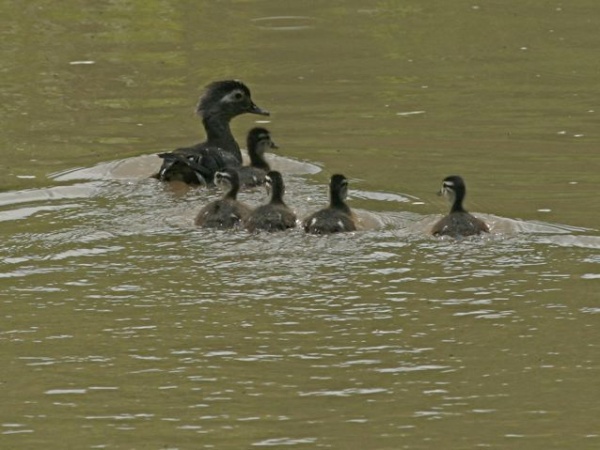
At the moment they hatch, baby birds are as small as the egg they came from but by the time they leave the nest they’re usually as big as their mother.
This is puzzling. How can a “baby” bird be so big? Aren’t babies small by definition?
Some are. Chuck Tague captured this sweet picture of a mother wood duck at Moraine State Park. Her babies are all we expect them to be, small and very cute.
Ducks, geese and shorebirds hatch precocial young, immediately mobile, relatively mature. As soon as ducklings hatch they walk — or in the case of wood ducks, jump — from the nest to the lake and swim away with momma. She leads them to the safest place.
Unfortunately there is almost no safe place for a duckling. They cannot fly to escape threats and they are not very quick swimmers. Snapping turtles, water snakes and large fish take their toll. That’s why ducks and geese lay up to a dozen eggs per brood. This mother wood duck is doing pretty well to have half her young still with her.
Most birds are the size of adults when we first see them. Have you noticed that you never see a baby pigeon?
Birds that nest on cliffs and don’t swim — peregrine falcons and rock pigeons, for instance — have only one way to leave the nest. They must fly, and they must do it well enough to navigate a windy place and land safely.
For these birds the first flight is all or nothing, so the young must be adult size and fully feathered before they make the attempt. If there weren’t webcams on peregrine nests we would never know the babies are small and white for several weeks. Pigeon nests don’t have webcams so we never see baby pigeons.
And so I come to the surprise people registered when they saw how big our fallen juvenile peregrine was. How could he get that big in 6 weeks? Why is he so big if he only left the nest 18 days ago?
It’s confusing until you remember that all baby birds grow to adult size in a matter of weeks. It’s just that with baby ducks, we get to see the process.
It’s so refreshing to see these cheerful little guys, after the sadness earlier this week.
You know, I never really thought about not seeing baby pigeons before!
I have been watching mother and father with two babies since two eggs were layed and its been fantastic. Now the babies are full size and I’m just a little bit worried because they haven’t walked or flown as far as I can tell. The parents watch from above or 2 feet or so from the nest. I left some food for the parents bacause they may have a hard time finding food, I am just worried because the babies look so lethargic but it has only been about 18 days since they were hatched. Apparently it takes a while for them to fly. The nest is in a place where it is very secluded (no people, no cars and no other birds…this might not be in their best interest. Also, there is some wire grating over the roof top that the parents have learned how to navigate (at first they got trapped but found their way out after 3 or 4 experiences like this) so I hope they will show the way out for the babies. If they don’t, I will have to take the babies for pets…I really don’t want to do that. It would mean keeping them in a cage plus I have a cat. So I am worried about these babies escaping their shangrila. Any suggestions?
You didn’t say what species of bird is involved. If you know the species, we can look up the number of days between hatch & fledge so you know what to expect.
The parents will definitely teach their young how to leave the area. You might be able to help by opening the hole a little more.
Unless these birds are pigeons, house sparrows or starlings, federal law prohibits you from keeping them as pets. If you “rescue” them you will have to take them to a wildlife rehab facility.
All in all, it is best to wait & see – and let nature take its course.
Precocial and Altricial Young
Here is a good article about young birds. Some take longer than others to leave the nest. Others pop right out
. This is from a very good book called “The Birder’s Handbook”.
The article from the book is posted on the Standford University’s website.
The article:
http://web.stanford.edu/group/stanfordbirds/text/essays/Precocial_and_Altricial.html
The book:
http://www.amazon.com/The-Birders-Handbook-Natural-American/dp/0671659898
The book has a lot of these articles on various topics. It also has a lot of articles on important scientists and other people who contributed knowledge to the world of birding including names like Swainson, Wilson, etc.